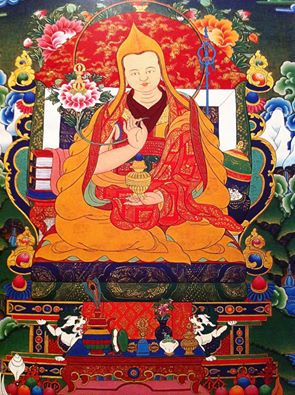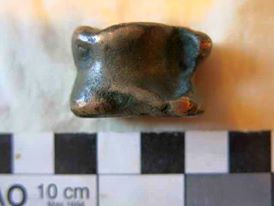
(An image of a blue the’u rang or tebrang spirit from a Tibetan manuscript. Scanned images from this manuscript of many Tibetan worldly spirits described in the post that follows can be found here at himalayanart.org but unfortunately the name and date of the source-text is not given. If anyone knows these details, please do let me know!)
I came across the following condensed directory of worldly spirits, gods, demons and other non-human Tibetan persons that go bump in the night in a book of essays which deal with the history and controversies surrounding the Tibetan protector-spirit Dolgyal, which I briefly discussed here. The book, whose short title is ‘The Impurity-Dispelling Mirror – An Investigation into the Origination and Controversy of Dolgyal’ was compiled by the Office of the Central Executive Committee of Dhomay (Amdo) Province in exile. The Committee spent some four odd years conducting research into the contentious spirit’s origins and nature and has penned a series of excellent essays explaining the role of spirit-protectors in Tibetan Buddhism and the development of the controversial sectarian issues associated with this spirit in particular. The essays in the book provide much needed context for a very complex issue, part of which revolves around divided opinions on the theological status of the spirit in question. Supporters of the spirit claim that it is a legitimate protector that is upholding its vows and deserving of propitiation; whereas His Holiness the Dalai Lama and numerous other authorities consider the being to be a harmful and demonic presence, a difficult to control hyper-zealous (and hyper-sectarian) force of violence and evil that should be avoided altogether. Continue reading



 had a dream in which a young Tibetan refugee woman was doing mo for clients. To ‘do mo’, ༼མོ་རྒྱག་པ་༽ ‘moh gyap pa’, means to tell the future, and over the centuries various divinatory systems, such as throwing dice, counting rosary beads, observing animal auguries, consulting spirit oracles, reading the pattern of rice on a drum skin, interpreting dreams, and scrying with brass mirrors to see visions, have played an important role in Tibetan civilization. In my dream I did not initially realize I was in a མོ་རྒྱག་ས་, a place of divination. I was in a dimly lit, low-ceiling-ed room – a number of individual computers stations were set up with chairs like in an Internet cafe and there were booths and tables dispersed around the screens padded in cheap blue, orange, and black imitation-leather like in some kind of diner (there was indeed a kitchen of sorts, that was serving food to customers).
had a dream in which a young Tibetan refugee woman was doing mo for clients. To ‘do mo’, ༼མོ་རྒྱག་པ་༽ ‘moh gyap pa’, means to tell the future, and over the centuries various divinatory systems, such as throwing dice, counting rosary beads, observing animal auguries, consulting spirit oracles, reading the pattern of rice on a drum skin, interpreting dreams, and scrying with brass mirrors to see visions, have played an important role in Tibetan civilization. In my dream I did not initially realize I was in a མོ་རྒྱག་ས་, a place of divination. I was in a dimly lit, low-ceiling-ed room – a number of individual computers stations were set up with chairs like in an Internet cafe and there were booths and tables dispersed around the screens padded in cheap blue, orange, and black imitation-leather like in some kind of diner (there was indeed a kitchen of sorts, that was serving food to customers).